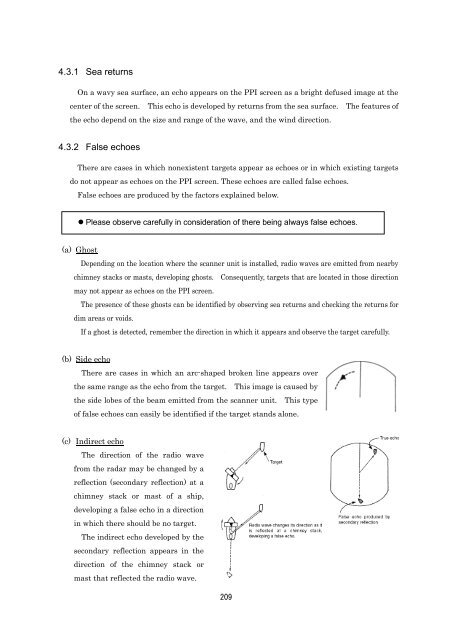JMA-2343/2344 - ProNav
JMA-2343/2344 - ProNav
JMA-2343/2344 - ProNav
Create successful ePaper yourself
Turn your PDF publications into a flip-book with our unique Google optimized e-Paper software.
4.3.1 Sea returns<br />
On a wavy sea surface, an echo appears on the PPI screen as a bright defused image at the<br />
center of the screen. This echo is developed by returns from the sea surface. The features of<br />
the echo depend on the size and range of the wave, and the wind direction.<br />
4.3.2 False echoes<br />
There are cases in which nonexistent targets appear as echoes or in which existing targets<br />
do not appear as echoes on the PPI screen. These echoes are called false echoes.<br />
False echoes are produced by the factors explained below.<br />
• Please observe carefully in consideration of there being always false echoes.<br />
(a) Ghost<br />
Depending on the location where the scanner unit is installed, radio waves are emitted from nearby<br />
chimney stacks or masts, developing ghosts. Consequently, targets that are located in those direction<br />
may not appear as echoes on the PPI screen.<br />
The presence of these ghosts can be identified by observing sea returns and checking the returns for<br />
dim areas or voids.<br />
If a ghost is detected, remember the direction in which it appears and observe the target carefully.<br />
(b) Side echo<br />
There are cases in which an arc-shaped broken line appears over<br />
the same range as the echo from the target. This image is caused by<br />
the side lobes of the beam emitted from the scanner unit. This type<br />
of false echoes can easily be identified if the target stands alone.<br />
(c) Indirect echo<br />
The direction of the radio wave<br />
from the radar may be changed by a<br />
reflection (secondary reflection) at a<br />
chimney stack or mast of a ship,<br />
developing a false echo in a direction<br />
in which there should be no target.<br />
The indirect echo developed by the<br />
secondary reflection appears in the<br />
direction of the chimney stack or<br />
mast that reflected the radio wave.<br />
209

















